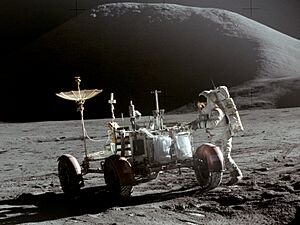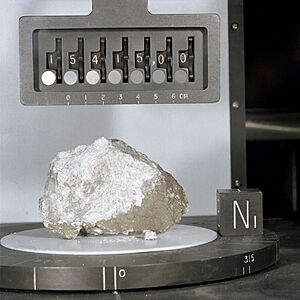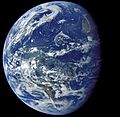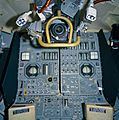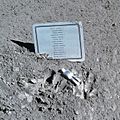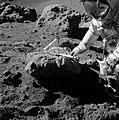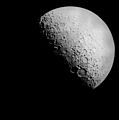Apollo 15 facts for kids

Jim Irwin salutes the United States flag on the Moon, August 1, 1971
|
|
| Mission type | Crewed lunar landing |
|---|---|
| Operator | NASA |
| Mission duration | 12 days, 7 hours, 11 minutes, 53 seconds |
| Spacecraft properties | |
| Spacecraft |
|
| Manufacturer |
|
| Launch mass | 48,599 kilograms (107,142 lb) |
| Landing mass | 5,321 kilograms (11,731 lb) |
| Crew | |
| Crew size | 3 |
| Members | |
| Callsign |
|
| EVAs | 1 in cislunar space and 4 on the lunar surface |
| EVA duration | 39 minutes, 7 seconds Spacewalk to retrieve film cassettes |
| Start of mission | |
| Launch date | July 26, 1971, 13:34:00.6 UTC |
| Rocket | Saturn V AS-510 |
| Launch site | Kennedy LC-39A |
| End of mission | |
| Recovered by | USS Okinawa |
| Landing date | August 7, 1971, 20:45:53 UTC |
| Landing site | North Pacific Ocean 26°7′N 158°8′W / 26.117°N 158.133°W |
| Orbital parameters | |
| Reference system | Selenocentric |
| Periselene | 101.5 kilometers (54.8 nmi) |
| Aposelene | 120.8 kilometers (65.2 nmi) |
| Inclination | 23 degrees |
| Epoch | July 30, 1971 |
| Lunar orbiter | |
| Spacecraft component | Command and service module |
| Orbital insertion | July 29, 1971, 20:05:46 UTC |
| Orbital departure | August 4, 1971, 21:22:45 UTC |
| Orbits | 74 |
| Lunar lander | |
| Spacecraft component | Lunar module |
| Landing date | July 30, 1971, 22:16:29 UTC |
| Return launch | August 2, 1971, 17:11:23 UTC |
| Landing site | 26°07′56″N 3°38′02″E / 26.1322°N 3.6339°E |
| Sample mass | 77 kilograms (170 lb) |
| Surface EVAs | 4 (including standup) |
| EVA duration |
|
| Lunar rover | |
| Distance covered | 27.9 kilometers (17.3 mi) |
| Docking with LM | |
| Docking date | July 26, 1971, 17:07:49 UTC |
| Undocking date | July 30, 1971, 18:13:16 UTC |
| Docking with LM Ascent Stage | |
| Docking date | August 2, 1971, 19:10:25 UTC |
| Undocking date | August 3, 1971, 01:04:01 UTC |
| Payload | |
|
|
| Mass |
|
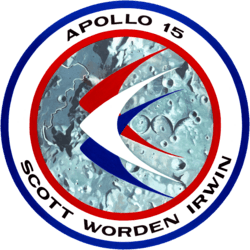 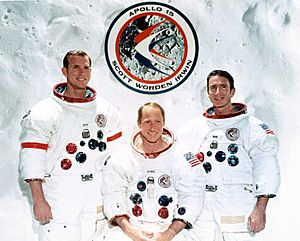 Left to right: Scott, Worden, Irwin |
|
Apollo 15 was an important space mission by NASA. It was the ninth time humans flew as part of the Apollo program. This mission was the fourth time astronauts landed on the Moon. It was also the first "J-Type" mission, meaning it was designed for longer stays on the Moon.
Apollo 15 launched on July 26, 1971. The crew included David Scott, James Irwin, and Alfred Worden. Worden stayed in orbit around the Moon in the Command Module, named Endeavour. Scott and Irwin landed on the Moon in the Lunar Module, called Falcon. They landed at a place called Hadley Base.
A big part of this mission was using the first ever Lunar Roving Vehicle. This special car allowed astronauts to travel much further on the Moon. It was built to work in space, where there is no air (a vacuum). It could also handle the Moon's rough ground and extreme temperatures. Scott and Irwin drove about 17.5 mi (28 km) on the Moon. They spent almost three days (66 hours, 55 minutes) exploring the lunar surface. During their time there, they collected many rock samples. They even got a core sample from 10 ft (3 m) deep into the Moon's surface.
Contents
Meet the Apollo 15 Astronauts
The Apollo 15 crew was made up of three brave astronauts.
- David Scott was the mission commander. He was one of the two astronauts who landed on the Moon.
- James Irwin was the Lunar Module pilot. He joined Scott on the Moon's surface.
- Alfred Worden was the Command Module pilot. He stayed in orbit around the Moon.
Exploring the Moon with the Lunar Rover
Apollo 15 was special because it was the first mission to use the Lunar Roving Vehicle, or LRV. This electric car changed how astronauts explored the Moon.
- It let Scott and Irwin travel much farther from their landing spot.
- They could cover more ground and collect more samples.
- The rover was designed to handle the Moon's dusty, rocky surface.
What Did They Find?
The astronauts collected a lot of Moon rocks and soil. They brought back about 77 kilograms (170 lb) of samples. One of the most famous finds was the Genesis Rock. Scientists believe this rock is very old, possibly from the early days of the Moon. Studying these samples helps us learn about how the Moon formed.
Living and Working on the Moon
Scott and Irwin spent over 19 hours outside their Lunar Module. They did three long spacewalks, called Extravehicular Activities (EVAs).
- During these EVAs, they set up scientific tools.
- They collected many rock and soil samples.
- They used the Lunar Rover to explore different areas.
While Scott and Irwin were on the Moon, Alfred Worden orbited above them. He took many photos and used special instruments to study the Moon from space. He also performed a spacewalk during the trip back to Earth to get film from outside the spacecraft.
Returning to Earth
After their amazing time on the Moon, Scott and Irwin lifted off in the Lunar Module's upper part. They rejoined Alfred Worden in the Endeavour Command Module. The crew then began their journey back to Earth. They landed safely in the North Pacific Ocean on August 7, 1971. The USS Okinawa ship was there to pick them up.
Images for kids
-
Commander David Scott takes a photograph during geology training in Hawaii, December 1970
-
The Chevrolet Corvettes driven by Scott (right) and Worden during the training for Apollo 15, photographed in 2019
-
The astronauts pose before the VAB as the Saturn V is rolled out
-
Command Module Endeavour on display at the National Museum of the United States Air Force in Dayton, Ohio
-
The spacesuit David Scott wore during the Apollo 15 mission is on display at the National Air and Space Museum, Washington, D.C.
See also
 In Spanish: Apolo 15 para niños
In Spanish: Apolo 15 para niños


